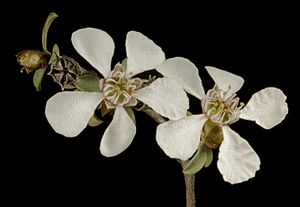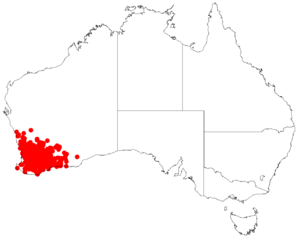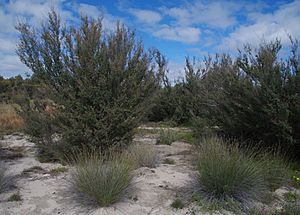Roadside tea tree facts for kids
Quick facts for kids Roadside tea tree |
|
|---|---|
 |
|
| Scientific classification | |
| Genus: |
Leptospermum
|
| Species: |
erubescens
|
 |
|
| Occurrence data from AVH | |
| Synonyms | |
|
Leptospermum erubescens Schauer var. erubescens |
|

The Leptospermum erubescens, often called the roadside tea tree, is a type of shrub that only grows in the southwest part of Western Australia. It has thin bark that looks like fibers, leaves shaped like eggs, small white flowers, and hard, woody fruits.
Contents
What Does the Roadside Tea Tree Look Like?
The roadside tea tree is a shrub that usually grows to be about 2 to 3 meters (6.5 to 10 feet) tall. It has thin, stringy bark that peels off in long strips.
Its young stems are thick and feel soft at first. They spread out widely. The leaves are attached directly to the stem without a stalk. They are narrow to broadly egg-shaped, usually 3 to 6 millimeters long and 2 to 4 millimeters wide.
The flowers grow alone or in pairs at the ends of short new branches. These branches keep growing even after the flowers appear. At the bottom of the flower buds, there are wide, reddish leaf-like parts called bracts and smaller bracteoles. The bracteoles fall off as the flowers open.
The flowers are white or pink and are less than 10 millimeters (about 0.4 inches) wide. They sit on a small stalk about 2 millimeters long. The cup-shaped part of the flower (called the floral cup) is hairy and 2 to 4 millimeters long. The sepals, which are like small leaves protecting the bud, are dark and about 1 millimeter long with hairy edges. The petals are about 5 millimeters long. The stamens, which produce pollen, are grouped in threes to fives and are 1.5 to 2 millimeters long.
This plant flowers from July to October. After flowering, it produces a hard, woody fruit called a capsule. This capsule is 4 to 5 millimeters wide and still has the remains of the sepals attached to it.
How Did the Roadside Tea Tree Get Its Name?
The Leptospermum erubescens was first officially described in 1844. This was done by a scientist named Johannes Conrad Schauer. He wrote about it in a book called Plantae Preissianae.
The second part of its scientific name, erubescens, comes from a Latin word. It means "reddening" or "blushing." This name likely refers to the color of its flowers.
Where Does the Roadside Tea Tree Grow?
The roadside tea tree can be found growing along the sides of roads, on flat lands, in small valleys, and among rocky areas. It grows in places with heath (low-growing shrubs) and woodlands.
It is found across many different natural areas in Western Australia. These areas include the Avon Wheatbelt, Coolgardie, Esperance Plains, Geraldton Sandplains, Jarrah Forest, Mallee, Swan Coastal Plain, Warren, and Yalgoo regions.
Is the Roadside Tea Tree Endangered?
The Government of Western Australia's Department of Parks and Wildlife has looked at this tea tree. They have classified it as "not threatened." This means it is not currently in danger of disappearing.

